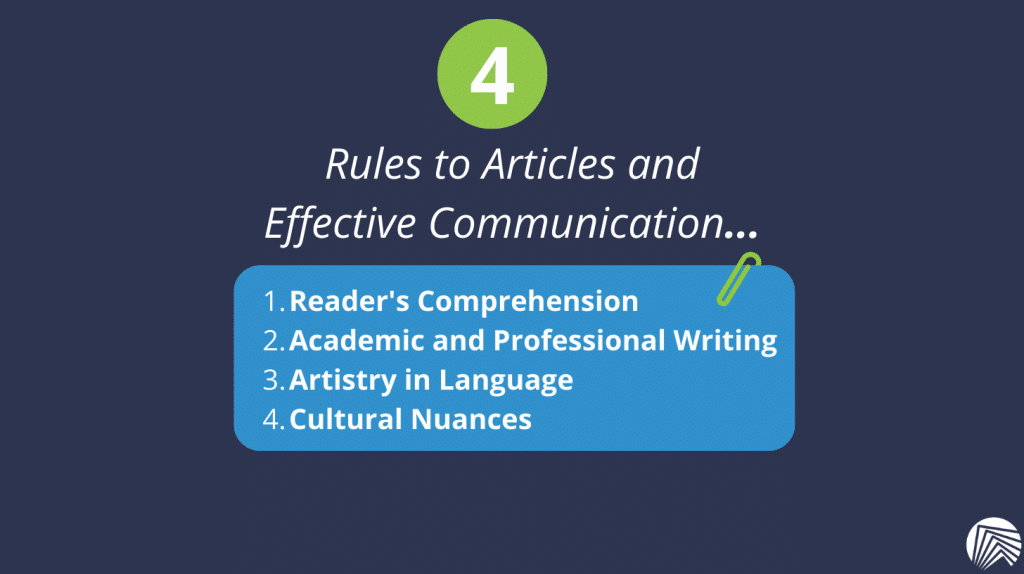The English language, with its rich tapestry of words and grammatical nuances, can be both fascinating and confounding. Among its many elements, articles, those seemingly small words like “a,” “an,” and “the,” play an incredibly significant role in shaping meaning and communication. In this article, we’ll delve into the world of articles in the English language, exploring why they are crucial for conveying meaning accurately and effectively.
Also read:
- Fundamentals of Scientific English Writing
- English Translation
- Post-Translation Editing
- Translation & English Editing Service

The Basics: What Are Articles?
Before we dive into the why, let’s start with the what. Articles are a type of determiner, a group of words that introduce nouns and provide information about them. In English, there are three articles: “a,” “an,” and “the.” They can be categorized into two main types:
Indefinite Articles: “A” and “An”
These articles are used when you’re referring to a non-specific item or one that hasn’t been previously mentioned in the conversation.
- “A” is used before words that begin with consonant sounds. For example, “a book,” “a car.”
- “An” is used before words that begin with vowel sounds. For example, “an apple,” “an hour.”
Definite Article: “The”
“The” is used when you’re referring to a specific item or something that has been previously mentioned or is generally known.
- For example, “the book I mentioned,” “the car parked outside.”
| Article Type | Usage | Examples |
|---|---|---|
| Definite Article | Used to refer to a specific noun. | The book, the cat, the car. |
| Indefinite Article | Used to refer to a general noun. | A book, an apple, a car. |
| Zero Article | Used when referring to a noun in a general sense or when it is a proper noun | Cats are cute, Paris is beautiful |
Why Articles Matter: Precision and Clarity
Articles may seem like small linguistic components, but they wield incredible power when it comes to conveying meaning accurately. Here’s why they matter:
Specificity and Uniqueness
Articles help you specify whether you’re talking about something in a general or specific sense. Let’s take a closer look:
- Indefinite Article (“a” or “an”): When you say, “I saw a dog,” you’re referring to any dog, not a particular one. It’s nonspecific.
- Definite Article (“the”): If you say, “I saw the dog,” you’re talking about a specific dog, one that your audience should be able to identify based on the context.
This ability to differentiate between the general and the specific is vital for clear communication.
Countability and Plurality
Articles also help determine whether a noun is countable (can be counted) or uncountable (cannot be counted). Consider these examples:
- Uncountable Noun: “I need information.” Here, “information” is uncountable. You’re not specifying a particular piece of information; you need it in a general sense.
- Countable Noun: “I need a piece of information.” In this case, “piece” makes “information” countable, and you’re asking for a specific unit of it.
Establishing Context
“The” is particularly useful for establishing context. By using it, you indicate that the noun following it is something the reader or listener should already be aware of or can easily discern.
For instance, imagine you’re discussing a book you’ve been reading. You might say, “The author’s use of symbolism is brilliant.” Here, “the author” refers to the specific author of the book you’ve been reading, creating clarity and context.
Nuance and Emphasis
The choice of article can also add nuance and emphasis to your message. Consider the following:
- “I bought a laptop yesterday.” This implies that you purchased a laptop, but it might not be a significant or unique event.
- “I bought the laptop yesterday.” Here, the use of “the” suggests that the purchase was notable or that there’s a specific laptop you’re referring to.
- “I bought my laptop yesterday.” By using “my,” you’re emphasizing that it’s your personal laptop, possibly distinguishing it from others.

Common Article Pitfalls: What to Watch Out For
While articles are powerful tools for precision and clarity, they can also be tricky, leading to common pitfalls in language use. Here are some challenges to be aware of:
Omission Errors
Sometimes, articles are unintentionally omitted, altering the meaning of a sentence. For example:
- “I’m going to store” should be “I’m going to the store.”
- “He’s reading book” should be “He’s reading a book.”
Overuse of Articles
Overusing articles can make your writing sound awkward and unclear. For instance:
- “I have a an cat” should be “I have a cat.”
Choosing the Wrong Article
Selecting the incorrect article can also lead to confusion. For example:
- “She’s an European” should be “She’s a European.”
- “I’m going to the university to study a chemistry” should be “I’m going to the university to study chemistry.”

The Bigger Picture: Articles and Effective Communication
Beyond the technical aspects, articles are vital for effective communication. They serve as signposts guiding readers or listeners through your message, helping them navigate the terrain of your ideas. Here’s how they contribute to the bigger picture:
Reader’s Comprehension
Proper use of articles aids readers in understanding your text. It allows them to identify key points, distinguish between general concepts and specifics, and follow the flow of your narrative.
Academic and Professional Writing
In academic and professional contexts, precise communication is essential. Articles help you convey complex ideas accurately, contributing to the credibility of your work.
Artistry in Language
Articles also play a role in the artistry of language. Writers can use them strategically to create rhythm, evoke emotions, or build suspense. Consider the impact of the definite article in phrases like “the dark forest” or “the enigmatic smile.”
Cultural Nuances
Articles can carry cultural nuances. Some languages, for instance, do not use articles in the same way as English. Understanding how articles work in a language can help bridge cultural gaps in communication.

Conclusion: The Unsung Heroes of Expression
In the grand symphony of language, articles are the unsung heroes. They may not steal the spotlight, but their absence or misuse can leave a narrative discordant and confusing. These small linguistic elements offer precision, clarity, and context, ensuring that your message reaches its destination with grace and accuracy.
So, the next time you craft a sentence or engage in conversation, remember the mighty articles. They are the invisible threads weaving meaning into every word and sentence, and they deserve recognition for their indispensable role in the beauty of language and the clarity of communication.




